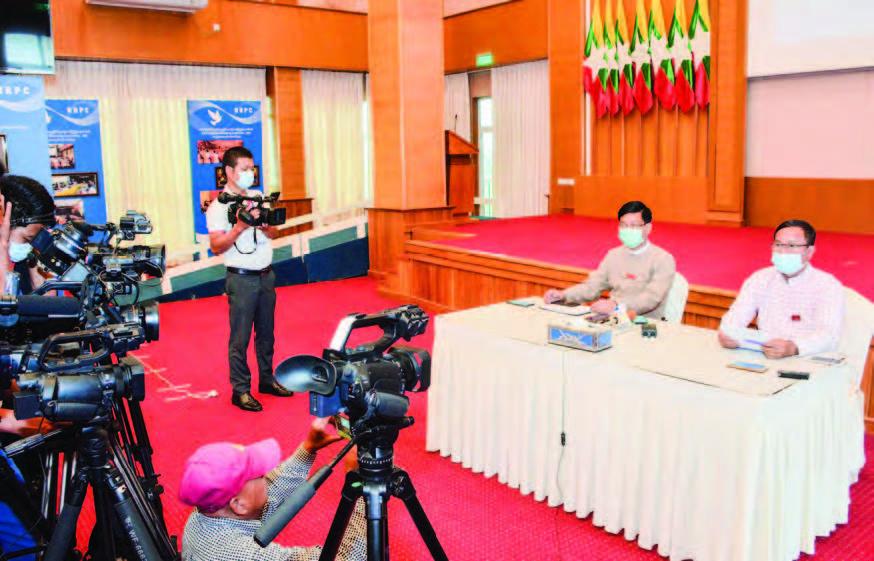THE 7th coordination meeting between the government and NCA-S EAOs was held at the National Reconciliation and Peace Centre (NRPC) in Nay Pyi Taw from 4 to 5 August.
Director-General U Zaw Htay of the Ministry of State Counsellor’s Office and NCA-S EAOs Representative Nai Aung Ma Ngay then held a press conference after the meeting.
Mostly favourable results
U Zaw Htay said they managed to agree to 14 points of the NCA implementation framework, Part I to the Union Accord, with only one point on amending the political dialogue framework left for discussion. He said they have also completed Table (1) of Part II of the Union Accord that focuses on successive stages of process and implementation after the year 2020. He said they have 8 topics single tested for discussion and implementation on that matter. Lastly, he said Table (2) goes into detail on the implementation process in all 3 stages and this is left for detailed discussions and negotiations.
He said they also discussed Part III of the Union Accord where they came to an agreement on two points concerning the fundamental guidelines for establishing a democratic federal Union. There are five points left to discuss. A working unit on the structure of the Union Accord was formed during the meeting and will meet up in the future. The meeting also agreed to hold the preliminary meetings to the JICM on 10 and 11 August with the JICM meeting on 13 August.
Next, Nai Aung Ma Ngay said the meeting was fruitful as they have finished discussion on Part I and have only a few topics to cover on Parts II and III. He said there will be a two-day meeting with the Peace Process Steering Team (PPST) in Nay Pyi Taw on moving forward.
AA will not be invited
Nai Aung Ma Ngay said they have asked the government to invite all EAOs that have not signed the Nationwide Ceasefire Agreement. While they have agreed to invite seven non-signatories to the peace conference they have officially announced they will not be inviting the AA. However, the government will invite the leader to attend if they so desire but not a representative, said Nai Aung Ma Ngay. He said he hopes the JICM meeting will produce good results for everyone.
Q&A
The questions and answers session then began. U Zaw Htay said they will be inviting seven non-signatories to the conference but they are legally unable to invite some of them. He said they will invite two leaders each from signatory and non-signatory groups. They will not be allowed to send representatives and only the invited leaders will be allowed to attend. He said this holds true for the 21 winning political parties as well who will only be allowed to send two leaders. Meanwhile, CSO Forum groups will be allowed 5 invitations but observers will not be able to attend as a precaution to COVID-19.
He said the JICM will convene on 13 August and the UPDJC on the 17th while the political parties will be briefed on the 14th. The UPDJC Secretariat meeting will be held on the 15th and the peace conference will go from the 19th to the 21st.
He said this means they will be holding the UPDJC meeting once before the peace conference and will discuss the agreements from the JICM meeting there and the Union Accord’s structure for further approval including the nature of signing. He said the UPDJC is the forefront of political dialogues but they had to restart at the JICM due to a deadlock between the government and EAOs.
UPC-21st Century Panglong
U Zaw Htay said the peace conference will be held for three days. On the first day, they will host the opening ceremony and hear keynote speeches from different leaders in the morning and have the UPDJC Secretariat meeting in the afternoon. Then on the second day, they will have the UPDJC meeting and the signing ceremony on the third day. From there, there will be Part III of the Union Accord, approving the decisions made at the 8th JICM at its 9th meeting, and then continuing the conference.
He said both sides are negotiating a more flexible approach than the situation that led to the deadlock. He said some concerns were addressed at this meeting, such as the structure of the Union Accord which will have successive levels of implementation after 2020. The Guiding Principle of Part III is important while Part I focuses on overcoming the issues in implementing the NCA, he said, adding that this is for creating a blueprint that can be implemented by the next government to take office after the upcoming elections.
He explained that after reviewing the 51 points of agreement from the previous three sessions of the peace conference, they were half-complete as they could be implemented despite being a part of the Union Accord, approved by the Pyidaungsu Hluttaw, and even approved for the different sectors they will impact. He said this Union Accord will designate a single action plan that can be implemented in three phases.
He said they will continue discussing technically after an agreement has been reached and begin implementation immediately after. He said establishing federalism and democracy is a long-term process and everyone has agreed that it must be taken step-by-step. He said this is similar to the gradual stages of amending the 2008 Constitution and states and regions will soon be able to draft their own subnational constitutions.
He said these preparations will allow the next government to take office to continue the discussions and implementations beyond 2020 while balancing the political and security aspects of both sides.
Myo Myint, Han Lin Naing
(Translated by Zaw Htet Oo)
Photo: HTIKE GYI
Ref: The Global New Light of Myanmar

